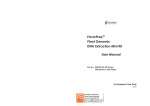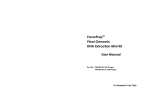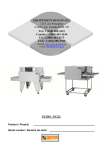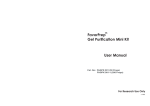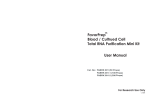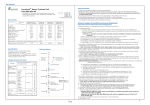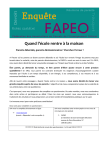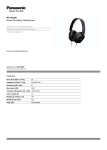Download FavorPrep Plant Genomic DNA Extraction Mini Kit User Manual
Transcript
FavorPrep Plant Genomic DNA Extraction Mini Kit TM User Manual Cat. No.: FAPGK 001 (50 Preps) FAP GK 001-1 (100 Preps) For Research Use Only v.0905 Introduction Genomic DNA Mini Kit provides a fast and simple method to isolate total DNA (genomic DNA, mitochondrial and chloroplast) from plant tissue Troubleshooting Problem Insufficient Lysis and cells. In the process, sample is distrusted by grinding in liquid nitrogen ‧Prolong the incubation time in lysis buffer to obtain and lysis buffer incubation. The Lysate is treated with RNase A to degrade higher yields of DNA. RNA and filtrated by filter column to remove cell debris and salt precipitations. Insufficient disruption In the presence of binding buffer with chaotropic salt, the genomic DNA in the lysate binds to glass fiber matrix in the spin column. The contamin ants are washed with an ethanol contained wash buffer and finally, Possible Reasons/ Solution ‧For most of species we recommend grinding with Low yield liquid nitrogen. Homogenization should be done thoroughly until the plant material is ground to the purified genomic DNA is eluted by low salt elution buffer or water. a fine powder. The protocol does not require DNA phenol extraction and alcohol precipitation. DNA still bound to the membrane The entire procedure can be completed in 60 minutes. The purified genomic ‧The DNA can be either eluted in higher volumes DNA is ready for PCR, real-time PCR, Southern blotting and RFLP. or by repeating the elution step up to three times. Elution buffer should be preheated to 60 oC prior to elution. ‧To ensure correct pH, use supplied elution buffer. Quality Control The quality of Plant Genomic DNA Mini Kit is tested on a lot-to-lot basis. The Kits are tested by isolation of genomic DNA from 50 mg young leave. Sample was contaminated with DNase ‧Preheat elution buffer to 60oC for 5 minutes to DNA is degraded eliminate any possible Dnase Centrifugation speed was too high ‧Higher velocities may cause shearing of the DNA. More than 10µg of genomic DNA could be quantified with The centrifugation maximum speed is at 11,000xg. spectrophotometer and checked by agarose gel. Too much tissue was used. ‧Too much tissue was used. Reduce the amount of sample material or separate it into multiple tubes. Sample: 100 mg of plant tissue Yield: 5~40µg Operation time: <60 min Column clogged Insufficient centrifugation ‧Centrifuge again and extend centrifugation time. Precipitate was formed at DNA Binding Step ‧Reduce the sample material. ‧Before loading the column, break up the precipitate in ethanol-added lysate by pipetting. 1 -FAP G K FAP G K-6 Kit Contents FAPGK 001 (50 preps) ‧Add 500µl of W1 Buffer (ethanol added) into the column. Step 4 Wash ‧Add 750µl of Wash Buffer (ethanol added) into FAPG1 Buffer the column. FAPG2 Buffer ‧Centrifuge at full speed (13,000 rpm) for 30 seconds. ‧Discard the flow-through and place the FAPG Column 50ml 8ml 15ml FAPG3 Buffer* 15ml 30ml W1 Buffer** 22ml 44ml Wash Buffer*** 10ml 20ml column matrix. ---Important Step! The residual liquid can affect the quallity of DNA and inhibit subsequent Elution Buffer 15ml 30ml back in the Collection Tube. RNase A (50mg/ml) 500µl 840µl Filter Column 50 pcs 100 pcs ‧Transfer dried FAPG Column into a clean 1.5 ml FAPG Column 50 pcs 100 pcs microcentrifuge tube (not provided). 1.5 ml Elution tube 50 pcs 100 pcs 2ml Collection tube 100 pcs 200 pcs ‧Add 50-200µl of preheated Elution Buffer into the center of the column matrix. ‧Stand for 3 minutes until Elution Buffer absorbed by the matrix. DNA Elution 24ml ‧Centrifuge at full speed for 3 minutes to dry the enzymatic reactions. Step 5 FAPGK 001-1 (100 preps) ‧Centrifuge full speed (13,000 rpm) for 2 minutes to *Add 30 ml/60 ml ethanol to FAPG3 Buffer before first use. **Add 8 ml/16ml ethanol to W1 Buffer before first use. ***Add 40 ml/80ml ethanol to Wash Buffer before first use. elute purified DNA. ---Important Step! For effective elution, make sure that the elution solution is dispensed on the membrane center and is absorbed completely. Caution ---Standard elution volume is 200µl. If less sample to 5 -FAP G K be used, reduce the elution volume (50-150µl) to The component contains irritant agent. During operation, always increase DNA concentration. wear a lab coat, disposable gloves, and protective goggles. FAP G K-2 Procedure Protocol Step 1 Tissue Dissociation Step 2 Lysis Step 3 DNA Binding 3 -FAP G K ‧Cut off 50mg (up to 100mg) of fresh or frozen plant tissue or 5 mg (up to 100 mg) of dried sample. ‧Grind the sample under liquid nitrogen to a fine powder. Transfer it into a microcentrifuge tube (not provided). For some plant sample, we can destruct it without liquid nitrogen. ‧Add 400 µl FAPG1 Buffer and 8µl RNase A (50 mg/ml) into the sample tube and mix by vortexing. Do not mix FAPG1 Buffer and RNase A before use. o ‧Incubate at 65 C for 10 minutes. During incubation, invert the tube every 5 minutes. At the same time, preheat required Elution Buffer (200µl per sample) o at 65 C. ‧Add 130µl FAPG2 Buffer and mix by vortexing. ‧Incubate at ice for 5 minutes. ‧Place a Filter Column in a 2 ml Collection Tube. ‧Apply the mixture from previous step to the Filter Column. Centrifuge for 3 minutes at full speed (13,000 rpm). ‧Discard the Filter Column and carefully transfer clarified supernatant in Collection Tube to a new microcentrifuge tube (not provided). ‧Add 1.5 volumes of FAPG3 Buffer (ethanol added) to the cleared lysate and mix immediately by vortexing for 5 seconds. For example, add 750µl FAPG3 Buffer to 500µl lysate. ‧Place a FAPG Column in a 2 ml Collection Tube. ‧Apply 750µl the mixture (including any precipitate) from previous step to the FAPG Column. ‧Centrifuge at full speed (13,000 rpm) for 2 minute. ‧Discard flow-through in Collection Tube and apply remaining mixture to FAPG Column. ‧Centrifuge at full speed (13,000 rpm) for 2 minute. ‧Discard flow-through in Collection Tube. FAP G K-4 Procedure Protocol Step 1 Tissue Dissociation Step 2 Lysis Step 3 DNA Binding 3 -FAP G K ‧Cut off 50mg (up to 100mg) of fresh or frozen plant tissue or 5 mg (up to 100 mg) of dried sample. ‧Grind the sample under liquid nitrogen to a fine powder. Transfer it into a microcentrifuge tube (not provided). For some plant sample, we can destruct it without liquid nitrogen. ‧Add 400 µl FAPG1 Buffer and 8µl RNase A (50 mg/ml) into the sample tube and mix by vortexing. Do not mix FAPG1 Buffer and RNase A before use. o ‧Incubate at 65 C for 10 minutes. During incubation, invert the tube every 5 minutes. At the same time, preheat required Elution Buffer (200µl per sample) o at 65 C. ‧Add 130µl FAPG2 Buffer and mix by vortexing. ‧Incubate at ice for 5 minutes. ‧Place a Filter Column in a 2 ml Collection Tube. ‧Apply the mixture from previous step to the Filter Column. Centrifuge for 3 minutes at full speed (13,000 rpm). ‧Discard the Filter Column and carefully transfer clarified supernatant in Collection Tube to a new microcentrifuge tube (not provided). ‧Add 1.5 volumes of FAPG3 Buffer (ethanol added) to the cleared lysate and mix immediately by vortexing for 5 seconds. For example, add 750µl FAPG3 Buffer to 500µl lysate. ‧Place a FAPG Column in a 2 ml Collection Tube. ‧Apply 750µl the mixture (including any precipitate) from previous step to the FAPG Column. ‧Centrifuge at full speed (13,000 rpm) for 2 minute. ‧Discard flow-through in Collection Tube and apply remaining mixture to FAPG Column. ‧Centrifuge at full speed (13,000 rpm) for 2 minute. ‧Discard flow-through in Collection Tube. FAP G K-4 Kit Contents FAPGK 001 (50 preps) ‧Add 500µl of W1 Buffer (ethanol added) into the column. Step 4 Wash ‧Add 750µl of Wash Buffer (ethanol added) into FAPG1 Buffer the column. FAPG2 Buffer ‧Centrifuge at full speed (13,000 rpm) for 30 seconds. ‧Discard the flow-through and place the FAPG Column 50ml 8ml 15ml FAPG3 Buffer* 15ml 30ml W1 Buffer** 22ml 44ml Wash Buffer*** 10ml 20ml column matrix. ---Important Step! The residual liquid can affect the quallity of DNA and inhibit subsequent Elution Buffer 15ml 30ml back in the Collection Tube. RNase A (50mg/ml) 500µl 840µl Filter Column 50 pcs 100 pcs ‧Transfer dried FAPG Column into a clean 1.5 ml FAPG Column 50 pcs 100 pcs microcentrifuge tube (not provided). 1.5 ml Elution tube 50 pcs 100 pcs 2ml Collection tube 100 pcs 200 pcs ‧Add 50-200µl of preheated Elution Buffer into the center of the column matrix. ‧Stand for 3 minutes until Elution Buffer absorbed by the matrix. DNA Elution 24ml ‧Centrifuge at full speed for 3 minutes to dry the enzymatic reactions. Step 5 FAPGK 001-1 (100 preps) ‧Centrifuge full speed (13,000 rpm) for 2 minutes to *Add 30 ml/60 ml ethanol to FAPG3 Buffer before first use. **Add 8 ml/16ml ethanol to W1 Buffer before first use. ***Add 40 ml/80ml ethanol to Wash Buffer before first use. elute purified DNA. ---Important Step! For effective elution, make sure that the elution solution is dispensed on the membrane center and is absorbed completely. Caution ---Standard elution volume is 200µl. If less sample to 5 -FAP G K be used, reduce the elution volume (50-150µl) to The component contains irritant agent. During operation, always increase DNA concentration. wear a lab coat, disposable gloves, and protective goggles. FAP G K-2 Introduction Genomic DNA Mini Kit provides a fast and simple method to isolate total DNA (genomic DNA, mitochondrial and chloroplast) from plant tissue Troubleshooting Problem Insufficient Lysis and cells. In the process, sample is distrusted by grinding in liquid nitrogen ‧Prolong the incubation time in lysis buffer to obtain and lysis buffer incubation. The Lysate is treated with RNase A to degrade higher yields of DNA. RNA and filtrated by filter column to remove cell debris and salt precipitations. Insufficient disruption In the presence of binding buffer with chaotropic salt, the genomic DNA in the lysate binds to glass fiber matrix in the spin column. The contamin ants are washed with an ethanol contained wash buffer and finally, Possible Reasons/ Solution ‧For most of species we recommend grinding with Low yield liquid nitrogen. Homogenization should be done thoroughly until the plant material is ground to the purified genomic DNA is eluted by low salt elution buffer or water. a fine powder. The protocol does not require DNA phenol extraction and alcohol precipitation. DNA still bound to the membrane The entire procedure can be completed in 60 minutes. The purified genomic ‧The DNA can be either eluted in higher volumes DNA is ready for PCR, real-time PCR, Southern blotting and RFLP. or by repeating the elution step up to three times. Elution buffer should be preheated to 60 oC prior to elution. ‧To ensure correct pH, use supplied elution buffer. Quality Control The quality of Plant Genomic DNA Mini Kit is tested on a lot-to-lot basis. The Kits are tested by isolation of genomic DNA from 50 mg young leave. Sample was contaminated with DNase ‧Preheat elution buffer to 60oC for 5 minutes to DNA is degraded eliminate any possible Dnase Centrifugation speed was too high ‧Higher velocities may cause shearing of the DNA. More than 10µg of genomic DNA could be quantified with The centrifugation maximum speed is at 11,000xg. spectrophotometer and checked by agarose gel. Too much tissue was used. ‧Too much tissue was used. Reduce the amount of sample material or separate it into multiple tubes. Sample: 100 mg of plant tissue Yield: 5~40µg Operation time: <60 min Column clogged Insufficient centrifugation ‧Centrifuge again and extend centrifugation time. Precipitate was formed at DNA Binding Step ‧Reduce the sample material. ‧Before loading the column, break up the precipitate in ethanol-added lysate by pipetting. 1 -FAP G K FAP G K-6







